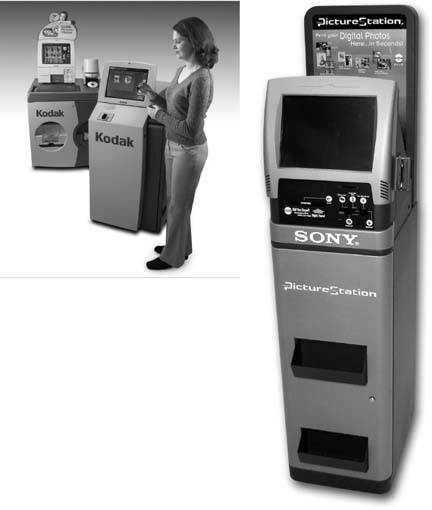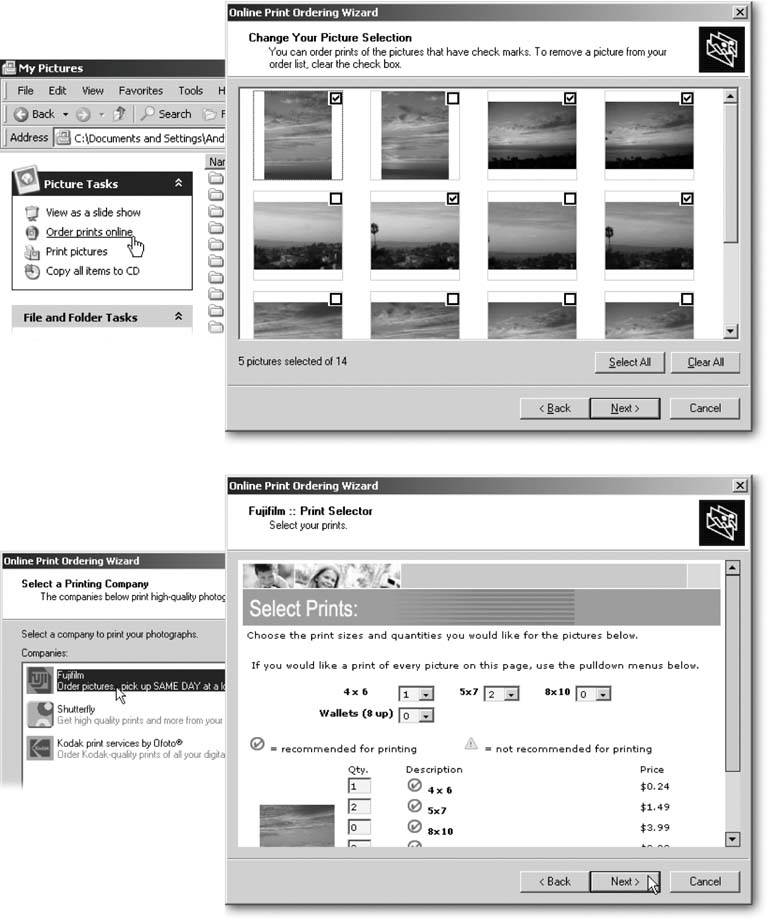Section 4.7. Printing Digital Photos Professionally
4.7. Printing Digital Photos ProfessionallyThose old photos in the shoebox usually look pretty darn good fifty years later, letting you chuckle over your grandparent's funny clothes. So consider this sobering fact before investing lots of money in photo paper and ink cartridges for your inkjet printer: the vast majority of pictures printed by today's photo printers fade in less than a decade . If they're exposed to direct sunlight, these photos may not last more than a few months. Some inkjets use water-soluble ink, which means that handling a photo with wet fingers does it in. The newest generation of inkjet printers, inks, and paper extends a printed photo's life, but at a cost: these archival printers cost several hundred dollars extra, and require more expensive paper and ink. And the manufacturer's longevity ratings for those prints applies only to photos kept under glass (or sealed in a protective sleeve), away from sunlight. That's why more people now turn to professional photo developers, since they accept digital photos as easily as they do traditional film. Better yet, they've priced their services so low that, picture for picture, they're often less expensive than printing at home. Professional photo developers accept digital photos in two ways, described in the next two sections. 4.7.1. In-Store KiosksMuch to the chagrin of the photo-developing industry, the vast majority of digital photos remain unprinted. To recapture that lost market, the big players want to make photo developing as easy as possibleand just as quick as using an inkjet printer. Their solution? The photo kiosks shown in Figure 4-11. Waiting for you in stores nationwide , kiosks print your digital files any way you bring them in, whether on a floppy disk, a CD, or still inside your camera. Although Kodak (www.kodak.com) and Sony (www.sony.com/picturestation) manufacture and sell the kiosks, each kiosk's owner sets their own costs for printing; prices average from 30 to 60 cents for a 4 x 6 print. Tip: For extra savings, visit the Kodak or Sony Web site before visiting their kiosks. As of this writing, both companies offer print-out discount coupons to present when paying for the photos. Figure 4-11. Left: Kodak (www.kodak.com) sprinkled more than 30,000 Picture Maker kiosks across the country in camera stores, drug stores, and shopping malls, making them the nation's biggest player in the digital photo kiosk department. Kodak's kiosks let you create prints from photos stored on digital camera memory cards, CDs, or floppy disks. The kiosks also accept photos beamed wirelessly from camera phones and PDAs, and they can even scan in existing photos and slides. The touch-sensitive screen lets you zoom, crop, remove " redeye ," adjust colors, and add borders before printing. |
| NOTE FROM THE LAWYERS Copyright, Photos, and Your Photo Developer |
| In 1999, the Professional Photographers of America sued Kmart, alleging the store violated federal copyright law by copying photos without the permission of the copyright owners . Kmart settled out of court by paying $100,000. Since then, photo developers and amateur photographers are left with an uncomfortable dilemma: there's no easy way to tell who holds the copyright on a photo. In the past, amateurs submitted entire rolls of film, complete with the usual blunders of bad lighting and chopped heads. But negatives are a rarity, these days. And amateur digital photographers send in computer-enhanced digital photo files that look fantasticso good, in fact, that some developers refuse to print them for fear of breaking copyright laws. To keep from violating copyright law, some photo developers simply guess as to whether you snapped the photo yourself. If your work looks too professional, they may not print it. For instance, Wal-Mart's Web site warns that it won't develop "any photograph that appears to have been taken by a professional photographer or studio, even if it isn't marked with any sort of copyright, unless we're presented with a signed Copyright Release." The moral? When submitting digital photos that look pretty darn good, be prepared to cough up your own copyright release form and convince the developer that you snapped those shots yourself. If the developer refuses, you may need to take your printing job elsewhere. |
- Structures, Processes and Relational Mechanisms for IT Governance
- Linking the IT Balanced Scorecard to the Business Objectives at a Major Canadian Financial Group
- Measuring and Managing E-Business Initiatives Through the Balanced Scorecard
- Governing Information Technology Through COBIT
- The Evolution of IT Governance at NB Power

